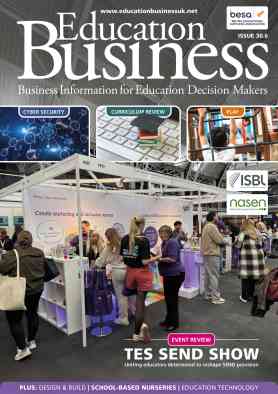An about turn for school stationery
 Shortly before the government reshuffle, Dominic Savage, director general of BESA asked Michael Gove what policy he was most proud of during his four-year term. He responded that it was the autonomy that he had given schools to create their own visions for what they wanted to achieve and how they would go about delivering something specific and owned by the school. At school level this hands-off approach is not how it was often perceived, but there have been clear signs of changing attitudes, particularly in the manner in which budgeting is pursued and questions are asked today about elements of budgeting that would not have been entertained in 2010.
Shortly before the government reshuffle, Dominic Savage, director general of BESA asked Michael Gove what policy he was most proud of during his four-year term. He responded that it was the autonomy that he had given schools to create their own visions for what they wanted to achieve and how they would go about delivering something specific and owned by the school. At school level this hands-off approach is not how it was often perceived, but there have been clear signs of changing attitudes, particularly in the manner in which budgeting is pursued and questions are asked today about elements of budgeting that would not have been entertained in 2010.
As the education sector’s trade association, the British Educational Suppliers Association (BESA) supports the industry to raise standards and make certain that resources are in line with teachers’ current needs. To ensure BESA has an insight into the sector and its changing requirements, the team meets with the DfE, teachers and suppliers throughout the year, and also carries out regular research. BESA shares the findings of its latest research looking specifically at the use of stationery in schools.
School resources
Looking first at schools’ current feelings about budgets and the availability of general resources, while some schools continue to indicate insufficient provision of all teaching resources, many are more optimistic about future funding after several years of pessimism.
We are certainly seeing schools become increasingly optimistic about funding in the next year. In addition, more head teachers than last year agree that their school has sufficient funding for resources such as furniture and their ICT infrastructure.
Investing in stationery
When asked about their spending focus for the school year 2014/15, the survey shows that primary schools are more likely to focus spending on continuing professional development (CPD), training, teaching aids, books and digital content than in 2013/14, while reducing the focus on staffing and building works. These are real changes to the approach to budgeting.
In comparison, secondary schools expect a significant positive shift in ICT spending, as well as on furniture and, CPD, but to a lesser extent. Staffing costs may suffer and there will probably be pressure on book and equipment spending.
The interesting change we are currently noticing is on the investment in stationery items. Before 2009, expenditure on general school items and stationery commonly recorded significant annual increases, especially in primary schools. The research defines stationery as general school items, including paper, exercise books, and administrative consumables. In most cases it excludes photocopying costs, but not paper.
Over the preceding decade before 2009/10, general school items and stationery expenditure averaged a growth of 2.4 per cent each year.
However from 2009/10 primary schools started to indicate reduced expenditure in this area. This was the first time since our records began that expenditure on general items across secondary in schools also showed persistent contraction.
This decline in expenditure continued last year, with spending on stationary down three per cent. However, it appears that this year the tables are turning.
Rise in orders
Looking ahead to the 2014/15 academic year, an increasing number of schools indicate funding will be in-line with the recent past, while 13 per cent of primary and eight per cent of secondary schools say it will increase.
Feedback from schools suggests that the spending reductions across general stationery items of recent years are at an end. In 2014/15 schools will start to increase their stationery orders, resulting in a slight increase in expenditure in this product area.
In terms of actual budget, in 2013/14 it was estimated that English maintained schools spent £136 million on general school items and stationery. It looks as if all possible strategies for savings in this area are exhausted and in this new academic year, after several years of decline, spending on general items and stationery is set to increase.
When we look at the increasing expenditure in all other resource areas, in 2014/15 it is estimated that English maintained schools will spend £1,244 million. The gain in spending is projected to be £56.6 million between 2013/14 and 2014/15. The increase in total national expenditure is, on a per-pupil basis, similar for primary and secondary.
So, while stationery is still lagging, there is clearly a new recognition of its importance. If this increase in expenditure follows the normal spending pattern in schools, we are likely to see spending on stationery continue to grow, moving back in line with long-term trends of around four per cent a year. After five years of decline, stationery expenditure starts to move up again.
Further information
www.besa.org.uk
Latest News
28/11/2025 - 09:38
Ofsted has confirmed plans to change inspections of local authorities’ children’s services (ILACS) in 2026 and 2027, including removal of overall effectiveness judgement from April 2026.
27/11/2025 - 11:53
Ofqual has published revised statistics on access arrangements for GCSEs, AS and A levels, alongside new research into the role of time pressure in assessment.
26/11/2025 - 15:22
The announcement follows an earlier pledge of £10 million in funding to provide every primary school in England with a library by 2029.
26/11/2025 - 10:18
The Diets Toolkit recommends that governments introduce more plant-based options in schools, alongside hospitals and other public institutions,
25/11/2025 - 13:05
New data from The Careers & Enterprise Company (CEC) finds that around two-thirds of businesses believe a two-week block of work experience is too time-consuming and offers too little benefit.







